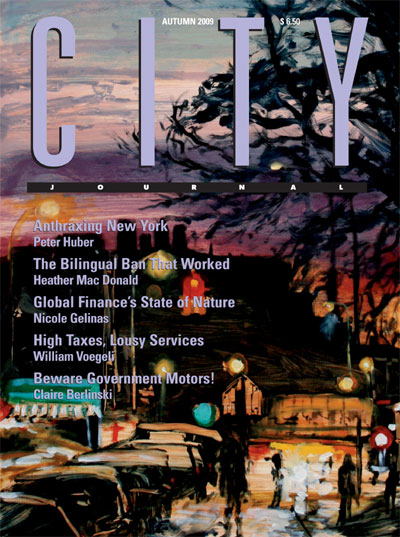We usually apply the word “feral,” which means “reverting to a wild state,” to domesticated animals that are abandoned and must survive on their own. But in rapidly shrinking Detroit, where tens of thousands of structures have sat empty for years, people are starting to describe houses and neighborhoods as feral—that is, as places where human activity ceased so long ago that nature has reclaimed them.
Two Detroit residents writing for the blog Sweet Juniper describe these feral houses as places that “for a few beautiful months during the summer . . . disappear behind ivy or the untended shrubs and trees planted generations ago to decorate their yards. The wood that frames the rooms gets crushed by trees. . . . The burnt lime, sand, gravel and plaster slowly erode into dust.” The bloggers’ striking photos show long-neglected houses completely enclosed in vegetation; only the outline of the architect’s design suggests something created by man buried beneath.
Feral houses are perhaps the most visible sign of Detroit’s long decline, and their troubling numbers are starting to create talk within the administration of Mayor Dave Bing, who is running for reelection in November, that the city must shrink to survive. Bing, the former National Basketball Association great who first won the mayor’s office in a special May election to replace the disgraced Kwame Kilpatrick, recalls how, during the campaign, he would travel through neighborhoods where only a house or two remained occupied on each block, where weeds had reclaimed abandoned lots, and where storefronts sat empty. Today, officials estimate, the city contains an astonishing 70,000 abandoned structures—many of them houses, but also some commercial properties. In downtown Detroit alone, a local newspaper identified 48 office buildings with “no outward sign of life.”
That’s not surprising, considering how many people have fled Detroit over the decades. Over the last half-century, the city’s population has shrunk by 50 percent, from about 1.8 million people to fewer than 900,000. Since 2000, the city has lost 35,000 residents. Detroit officials acknowledge that they see little prospect for a population turnaround soon.
Though any plan to downsize Detroit—a city where people now use only half the acreage within its boundaries—would be complicated, expensive, and time-consuming, it would let the city focus its resources, including crime-fighting and redevelopment efforts, where they could do the most good. The first phase in such a plan would involve tearing down abandoned houses and other empty structures that serve as focal points for criminal activity. But that itself is a daunting task. City officials say that it takes an average of $10,000 to demolish an abandoned house, which makes the city’s long-term tab potentially north of $700 million. This summer, Detroit used federal grants to start the task, demolishing some 226 abandoned houses in areas near neighborhood schools to reduce criminals’ opportunities to prey on schoolchildren.
Downsizing Detroit also presents political obstacles. Officials must identify neighborhoods whose city services would be withdrawn and whose residents would be relocated, a process certain to set off political fireworks. A summer series in a Detroit newspaper quoted some residents of desolate neighborhoods as welcoming such relocation efforts; others vowed to resist.
Yet doing nothing is no longer an option: the city’s economic and fiscal woes are already forcing deep cuts in services. Detroit’s board of education, for instance, resisted downsizing for years and continued until 2007 to operate a school system with a capacity for 160,000 students, even though just 115,000 students attended that year. The hemorrhaging budget finally forced the city to close some 40 schools. But the system still faces insolvency and is even considering a bankruptcy filing. Similar budget crises will require rolling back various other essential services, from police and fire to sanitation.
Though some blame Detroit’s population losses on larger economic forces, economists Edward Glaeser and Andrei Shleifer argue in a groundbreaking paper that the city’s problems are mostly self-inflicted. (The paper, called “The Curley Effect,” gets its name from legendary Boston mayor James Curley, who favored Irish residents and pushed other groups out.) After winning election in 1973, Detroit’s first black mayor, Coleman Young, consolidated his power, driving white residents, who had voted against him, out of the city by withdrawing services from their neighborhoods. Eventually, Glaeser and Shleifer write, Detroit became “an overwhelmingly black city mired in poverty and social problems”—and shrinking fast.
